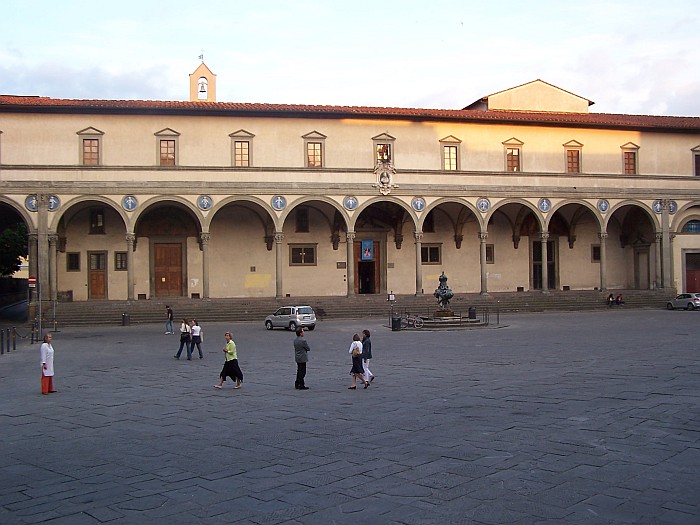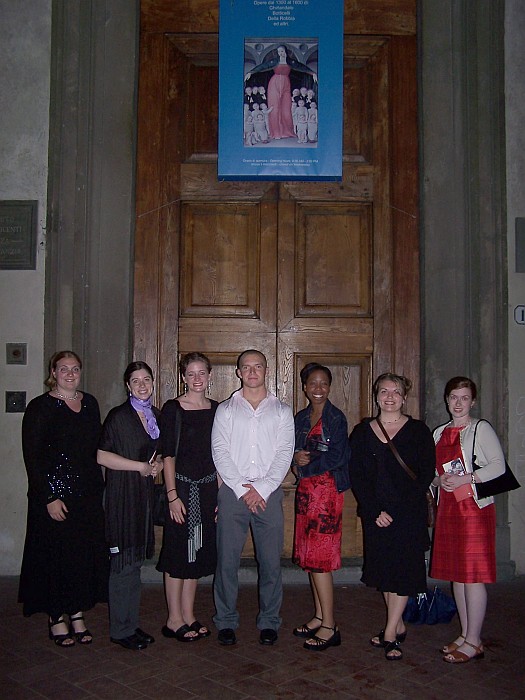(Italian pronunciation: oh-speh-dah-lay day-lyee een-no-chehn-tee)

The city orphanage was Brunelleschi's first completed Classical design.

The city orphanage was Brunelleschi's first completed Classical design.
In the early XVth century Florence was one of the most prosperous cities of Europe. Its economy was based on a strong textile industry and on an effective banking system supported by a reliable gold currency (florin). Merchants and artisans were grouped in powerful guilds: in 1421 Arte della Seta, the Silk Guild, decided to contribute to the well-being of the Republic by founding Spedale degli Innocenti probably the first foundling hospital.
The Silk Guild, which included also goldsmiths and other metalworkers who produced luxury goods, asked one of its members, the goldsmith Filippo Brunelleschi to prepare a design for the new hospital. Brunelleschi was praised as a sculptor, but he had no background as an architect. He had however extensively studied for two years the ancient buildings of Rome with his friend Donatello. The long portico he designed for the hospital was a striking novelty for Florence, its first building inspired after classical antiquity.
Brunelleschi is regarded as the founder of Italian Renaissance architecture: his studies of the buildings of Ancient Rome influenced his works, which however were not imitative of them: the proportions between the various architectural elements were entirely new: each bay of the portico has the same length, width and height. The way he linked columns to arches became a pattern followed by many other Renaissance architects and the highlighting of the building design by using a grey stone (pietra serena) on a white surface became a typical feature of Florentine architecture.
The institution flourished through the centuries and when the Silk Guild was no longer able to financially support it, the City of Florence took responsibility for it. The children residing in Spedale degli Innocenti were not only orphans and foundlings, but also children of families in temporary difficult conditions. The building maintained its original use until the end of the XIXth century, when, in consideration of its historical and artistic value, it was felt more appropriate to use it as a museum. It still hosts two small kindergartens. If your surname happens to be Innocenti, Nocentini, Degl'Innocenti, your family roots most likely started in this building (other surnames having the same origin are Esposti, Esposito, Degli Esposti).
Many artists contributed their works to the embellishment of Spedale degli Innocenti: Andrea della Robbia placed his elegant ceramic glazes in the cavities designed by Brunelleschi in the arches of the portico; the children followed processions behind Madonna dei Trovatelli (foundlings), an inspired banner painted by Domenico di Michelino; even the window where babies could be left anonymously was nicely decorated.

This hospital is named after Herod's biblical Massacre of the Innocents following the birth of Jesus. It opened in 1444 as the first orphanage in Europe, and part of the building is still used for this purpose. UNICEF, the United Nations Children's Fund, also has offices here.
The church of the Foundlings' Hospital was part of the complex designed by Brunelleschi (1419-1424), and was reached from an entrance in the portico, near the rota where unwanted infants were abandoned. (It was a rotating stone cylinder on which mothers could place their unwanted children anonymously and ring the orphange bell. The stone was then turned around and the child was taken in.) Brunelleschi's arcaded loggia is decorated with glazed terracotta roundels, added by Andrea della Robbia around 1498, showing babies wrapped in swaddling bands. The lunette over the doorway was frescoed by Giovanni Francesco del Cervelliera with God the Father and the Holy Innocents (1459). The 15th-century church was entirely rebuilt by the architect Bernardo Fallani in 1786, and Sante Pacini frescoed the ceiling with Moses saved from the waters. On the high altar, an Annunciation by Giovanni Antonio Sogliani (c. 1517) replaced Domenico Ghirlandaio's Adoration of the Magi (1488), commissioned by Francesco Tesori, which is now in the Hospital Museum together with other works from the church.

Within the building there are two elegant cloisters built to Brunelleschi's designs. The larger Chiostro degli Uomini (Men's Cloister), built between 1422 and 1445, is decorated with sgraffto designs of cherubs and roosters scratched into the wet plaster. The smaller Women's Cloister (1438) leads to a gallery which has several paintings donated by children from the orphanage who went on to be successful in later life.
